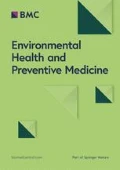Abstract
Objectives
The present study measures heart rate (HR) on a number of professional race-car drivers during actual car races through annual seasons to test hypotheses that faster relative speed and higher cabin temperature would induce higher HR.
Methods
Heart rates in fifteen male drivers (31.2 ± 5.5 years old) were obtained by chest-strap sensors during official-professional 13 races. Average HR was calculated while the driver was racing from the start to the end of each race.
Results
The average HR during races was 164.5 ± 15.1 beats min−1 and the average amount of time each driver spent driving per race was 54.2 ± 13.7 min. Average HR significantly and positively correlated with mean speed ratio (P < 0.001), but not with the average cabin temperatures (P = 0.533, range 25.6–41.8 °C) by the multiple linear regression analysis. Both average HR and mean speed ratio were significantly lower under wet, than dry conditions (151.9 ± 16.5 vs. 168.3 ± 12.5 beats min−1, 86.9 ± 4.4 vs. 93.4 ± 1.5 %).
Conclusions
The cardiovascular system of drivers is considerably stressed at extremely high HR. This high average HR positively correlated with mean speed ratio, suggesting that faster driving speed would induce greater cardiovascular stress to professional drivers during actual races. However, contrary to our hypothesis, cabin temperature was not significantly correlated with average HR. It is speculated that direct body cooling systems used in this professional race category work well against increases in HR by thermal stress under the temperature range found herein.




Similar content being viewed by others
References
Potkanowicz ES, Mendel RW. The case for driver science in motorsport: a review and recommendations. Sports Med. 2013;43:565–74.
Watkins ES. The physiology and pathology of formula one Grand Prix motor racing. Clin Neurosurg. 2006;53:145–52.
Yamakoshi T, Matsumura K, Yamakoshi Y, et al. Physiological measurements and analyses in motor sports: a preliminary study in racing kart athletes. Eur J Sport Sci. 2010;10:397–406.
Jacobs PL, Olvey SE, Johnson BM, Cohn K. Physiological responses to high-speed, open-wheel racecar driving. Med Sci Sports Exerc. 2002;34:2085–90.
Brearley MB, Finn JP. Responses of motor-sport athletes to v8 supercar racing in hot conditions. Int J Sports Physiol Perform. 2007;2:182–91.
Matsumura K, Yamakoshi T, Yamakoshi Y, Rolfe P. The effect of competition on heart rate during kart driving: a field study. BMC Res Notes. 2011;4:342.
Küçükdurmaz F. Driver as a high level athlete. In: Doral MN, editor. Sports injuries: prevention, diagnosis, treatment and rehabilitation. Berlin: Springer; 2012. p. 1121–3.
Taggart P, Carruthers M. Endogenous hyperlipidaemia induced by emotional stress of racing driving. Lancet. 1971;1:363–6.
Schwaberger G. Heart rate, metabolic and hormonal responses to maximal psycho-emotional and physical stress in motor car racing drivers. Int Arch Occup Environ Health. 1987;59:579–604.
Jareño A, de la Serna JL, Cercas A, et al. Heat stroke in motor car racing drivers. Br J Sports Med. 1987;21:48.
Yamakoshi T, Matsumura K, Rolfe P, et al. A novel method to detect heat illness under severe conditions by monitoring tympanic temperature. Aviat Space Environ Med. 2013;84:692–700.
Suzuki Y, Takezaki D, Takahashi K. Development of driver cooling system with air conditioner for racing car (Japanese). J Soc Automot Eng Jpn. 2009;63:84–9.
World Medical Association. World Medical Association Declaration of Helsinki: ethical principles for medical research involving human subjects. World Med J. 2013;59:199–202.
RS800CX User Manual. Polar electro Oy, Kempele, Finland.
Wallén MB, Hasson D, Theorell T, Canlon B, Osika W. Possibilities and limitations of the polar RS800 in measuring heart rate variability at rest. Eur J Appl Physiol. 2012;112:1153–65.
Ogawa Y, Yanagida R, Ueda K, Aoki K, Iwasaki K. The relationship between widespread changes in gravity and cerebral blood flow. Environ Health Prev Med. 2016 (epub ahead of print).
Yanagida R, Ogawa Y, Ueda K, Aoki K, Iwasaki K. Sustained mild hypergravity reduces spontaneous cardiac baroreflex sensitivity. Auton Neurosci. 2014;185:123–8.
Hood WB Jr, Murray RH, Urschel CW, Bowers JA, Clark JG. Cardiopulmonary effects of whole-body vibration in man. J Appl Physiol. 1966;21:1725–31.
Inoue Y, Ichinose-Kuwahara T, Nakamura S, Ueda H, Yasumatsu H, Kondo N, Araki T. Cutaneous vasodilation response to a linear increase in air temperature from 28 °C to 40 °C in prepubertal boys and young men. J Physiol Anthropol. 2009;28:137–44.
Minoyama O, Tsuchida H. Injuries in professional motor car racing drivers at a racing circuit between 1996 and 2000. Br J Sports Med. 2004;38:613–6.
Weaver CS, Sloan BK, Brizendine EJ, Bock H. An analysis of maximum vehicle G forces and brain injury in motorsports crashes. Med Sci Sports Exerc. 2006;38:246–9.
Acknowledgments
We thank the GT Association Co., Ltd. of Japan, A Speed, AUTOBACS Racing Team AGURI, LEXUS TEAM SARD, LEXUS TEAM WedsSport BANDOH, MOLA, NISMO, TEAM KUNIMITSU and the Japanese Automobile manufacturers Honda Motor Co., Ltd., Nissan Motor Co., Ltd. and Toyota Motor Corporation for valuable support during the project. We also appreciate the assistance of S. Udagawa PhD for reviewing the statistical analyses. This study was supported by our institutional fund (The Nihon University School of Medicine). This report was previously presented, in part, at “The 82nd Annual meeting of the Japanese Society for Hygiene”.
Author information
Authors and Affiliations
Corresponding author
Ethics declarations
Conflict of interest
The authors have no conflicts of interest to declare.
Rights and permissions
About this article
Cite this article
Yanagida, R., Takahashi, K., Miura, M. et al. Speed ratio but cabin temperature positively correlated with increased heart rates among professional drivers during car races. Environ Health Prev Med 21, 439–445 (2016). https://doi.org/10.1007/s12199-016-0544-0
Received:
Accepted:
Published:
Issue Date:
DOI: https://doi.org/10.1007/s12199-016-0544-0




